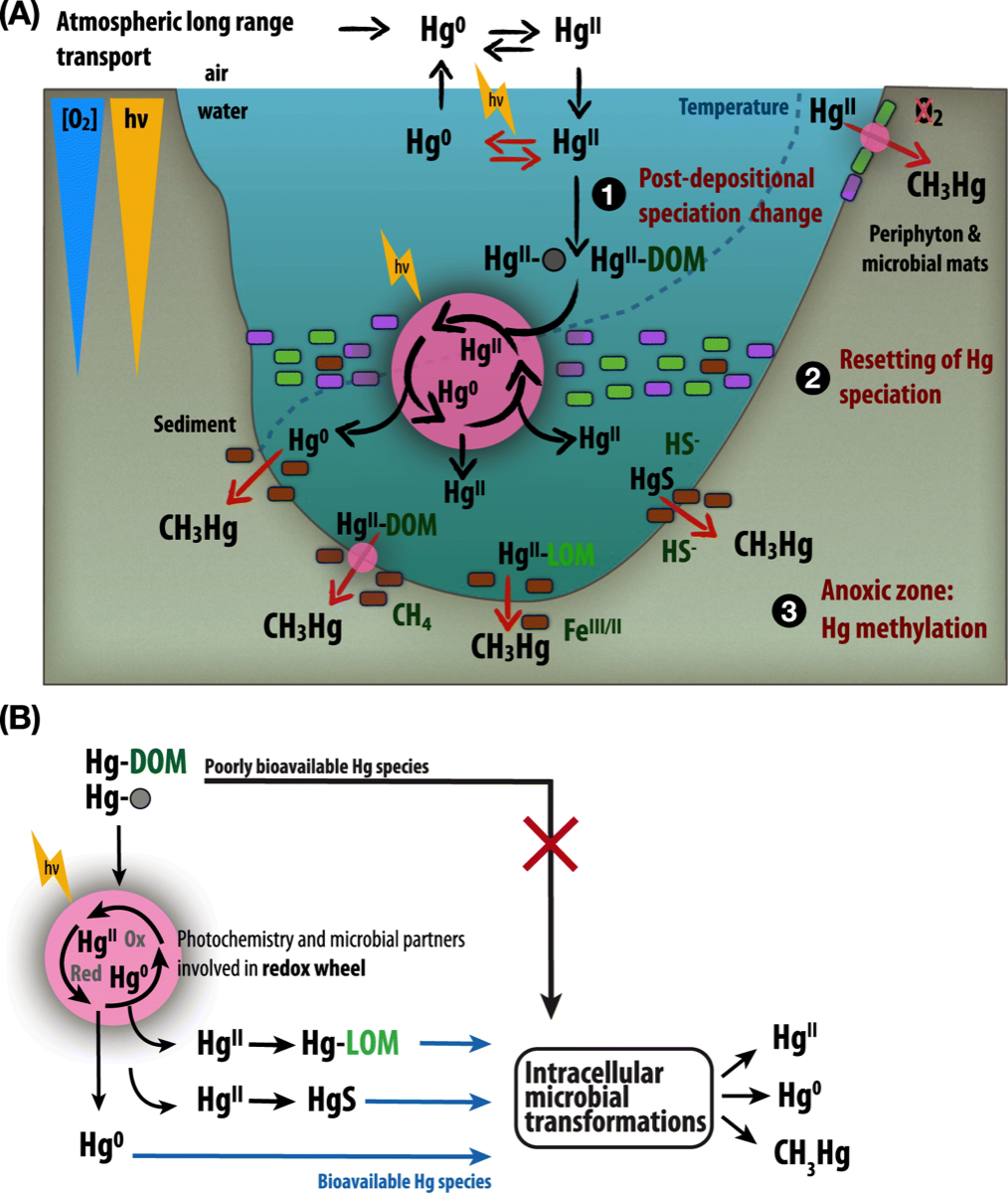Mercury and Metals Biogeochemistry
1. Mercury biogeochemistry across latitudinal gradients | Biogéochimie du Hg des zones tempérées et arctiques
2. Microbes as catalysts of metal transformations | Les microorganismes en tant que catalyseurs de transformation des éléments traces métalliques (ETMs)
Specifically, we are testing the hypothesis that redox reactions contribute to reset Hg speciation and produce bioavailable species directly delivered to microbes responsible for the production of the neurotoxin, monomethylercury (see figure below).
1. Mercury biogeochemistry across latitudinal gradients | Biogéochimie du Hg des zones tempérées et arctiques
2. Microbes as catalysts of metal transformations | Les microorganismes en tant que catalyseurs de transformation des éléments traces métalliques (ETMs)
Specifically, we are testing the hypothesis that redox reactions contribute to reset Hg speciation and produce bioavailable species directly delivered to microbes responsible for the production of the neurotoxin, monomethylercury (see figure below).

Conceptual summary for the possible role of phototrophic and anaerobic microbes in controlling Hg bioavailability.
The pink disks highlight sites where Hg speciation can be reset via redox processes that directly affect Hg (see text) or the ligands to which Hg is bound (e.g., via heterotrophy or DOM photo-transformation). These processes can occur in oxic or anoxic conditions and be catalyzed by light, microbes, or both. At the ecosystem scale (panel A), anoxygenic phototrophs are represented in green and purple, Hg methylators are represented in brown, dissolved organic matter has been abbreviated as DOM, labile organic matter available to microbes is abbreviated as LOM, and particulate matter is denoted by small grey circles. Hg-DOM represents poorly bioavailable Hg complexes formed with organic matter ligands of a large size. Hg-LOM represents highly bioavailable Hg complexes formed with labile organic matter ligands; these labile organic matter ligands can act as shuttles for Hg inside the cell. Lightning bolts represent light energy (hν) required for photobiological or photochemical processes. Inverted blue and yellow triangles represent oxygen and light energy gradients, respectively. HS− (sulfide), CH4 (methane), and FeII/III (iron oxides) are meant to represent some of the anaerobic metabolisms known to be involved in Hg metabolism: sulphatoreduction, methanogenesis, and ferroreduction, respectively. Panel B was adapted from Chiasson-Gould et al. 2014 and represents the redox wheel in the context of the diversity of Hg species available for microbial transformations.
Source: Gregoire and Poulain, FACETS, 2018
The pink disks highlight sites where Hg speciation can be reset via redox processes that directly affect Hg (see text) or the ligands to which Hg is bound (e.g., via heterotrophy or DOM photo-transformation). These processes can occur in oxic or anoxic conditions and be catalyzed by light, microbes, or both. At the ecosystem scale (panel A), anoxygenic phototrophs are represented in green and purple, Hg methylators are represented in brown, dissolved organic matter has been abbreviated as DOM, labile organic matter available to microbes is abbreviated as LOM, and particulate matter is denoted by small grey circles. Hg-DOM represents poorly bioavailable Hg complexes formed with organic matter ligands of a large size. Hg-LOM represents highly bioavailable Hg complexes formed with labile organic matter ligands; these labile organic matter ligands can act as shuttles for Hg inside the cell. Lightning bolts represent light energy (hν) required for photobiological or photochemical processes. Inverted blue and yellow triangles represent oxygen and light energy gradients, respectively. HS− (sulfide), CH4 (methane), and FeII/III (iron oxides) are meant to represent some of the anaerobic metabolisms known to be involved in Hg metabolism: sulphatoreduction, methanogenesis, and ferroreduction, respectively. Panel B was adapted from Chiasson-Gould et al. 2014 and represents the redox wheel in the context of the diversity of Hg species available for microbial transformations.
Source: Gregoire and Poulain, FACETS, 2018
3. Microbial phototrophy | Les phototrophies microbiennes
4. Metal(loid)s bioavailability to microbes | Prise en charge des ETMs par les microorganismes
5. Paleogenomic indicators of microbial exposure to toxic metals | Paléoindicateurs génomiques microbiens d'exposition historique aux contaminants
Microbes - Plants interactions
6. With colleague Prof. MacLean we are investigating the potential for distillery stillage to be used as a fertilizer. | Nous étudions la possibilité d'utiliser les résidus de distillerie comme engrais (collaboration avec Prof. MacLean).
Microbes - insects interactions
7. With colleague Prof. Forrest we are interested in how insect microbiota contributes to fitness when exposed to contaminants. Nous nous intéressons au rôle du microbiote des insectes sur leur capacité à interagir avec les contaminants, tels les pesticides (collaboration avec Prof. Forrest).
Biosensor development
8. We are working with the First Nations of Quebec and Labrador Sustainable Development Institute and Environment and Climate Change Canada to design and deploy field-ready biosensing tools targeting steroids and sex hormones collected from caribous. This work is conducted in collaboration with Prof. Trudeau. | Nous travaillons avec l'Institut du développement durable des Premières Nations du Québec et du Labrador pour concevoir et déployer des outils de biodétection prêts à l'emploi ciblant les stéroïdes et les hormones sexuelles prélevés à partir de caribous. Ces travaux sont menés en collaboration avec le professeur Trudeau.